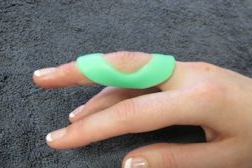
Finger sprains and dislocations most commonly occur at the proximal interphalangeal joint (PIPJ). When a finger is sprained, it is likely that the collateral ligaments or volar plate that surrounds PIPJ has been torn. PIPJ dislocations may occur if the finger sprain is severe. Finger sprains and dislocations often occurs when the finger is hyperextended. This happens regularly during ball sports when the ball hits the end of the finger.

What are the symptoms?
- Finger appears swollen
- Red and painful when touched
- Have trouble closing your fingers into a fist
- If severe, you may notice a deformity on your finger
What type of treatment is there for finger sprains and dislocations?
Your hand therapist will fabricate a thermoplastic splint for you to wear for protection and educate you on finger exercises. They may also provide you with garments to help reduce swelling. If the dislocation is severe, they will refer you to a Hand Surgeon to for a surgical opinion.


